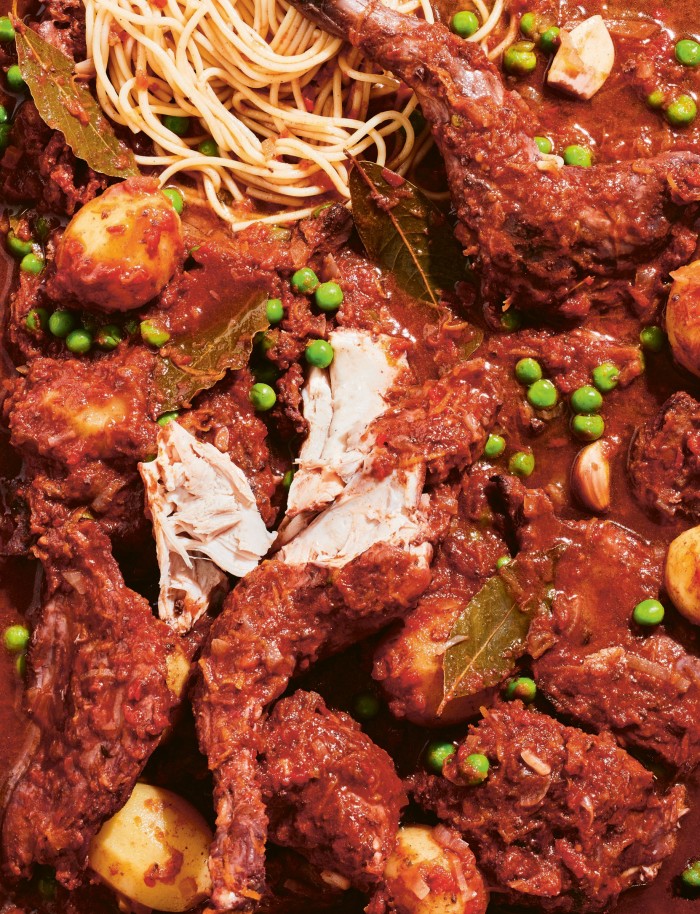A Maltese stew to hop to

Roula Khalaf, Editor of the FT, selects her favourite stories in this weekly newsletter.
I am making rabbit stew. This may not sound very summery, but in Malta they eat rabbit stew year-round, and especially in summer. At the feast of L-Imnarja, celebrated towards the end of June to commemorate Saints Peter and Paul, candles and bonfires are lit, Maltese folk music is played and the national dish of fenkata (rabbit stew) is savoured by all.
A stew feast in June isn’t for everyone. “When you visit Malta and stand in that heat, it doesn’t make sense,” admits food writer Simon Bajada. Yet he’s the one who’s got me onto rabbit stew, which he raves about for its texture and heartiness. Bajada grew up in Adelaide, spent time in Melbourne and now lives with his Swedish wife and two children in Stockholm. He’s written cookbooks on Baltic and Nordic cuisines, fuelled by his interests as an outsider. But his latest book, Malta – Mediterranean Recipes from the Islands (Hardie Grant), draws on his own heritage as half-Maltese on his father’s side.
Having grown up abroad, he found working on the book an eye-opener. “I went to school with a lot of Maltese kids but I never realised they were Maltese until I started making trips to Malta for this book and saw their names everywhere,” he says. “One of the ingredients that stood out as being uniquely Maltese was tomato paste. I pictured my cousins and I licking tomato paste out of a jar when we were kids.”
But what exactly is Maltese cuisine? While it draws on influences from Sicily, north Africa and Britain (of which it was a colony until 1964) that ushered in ingredients such as cheddar and corned beef, Maltese cooking is classically Mediterranean. The pantry includes produce such as tomatoes, broad beans, capers, olives, ricotta, pasta and fish, especially mahi-mahi.

“It’s old-world cooking,” says Bajada. No fancy kitchen skills. Soups and stews that would have sat by the fire in pots. “And dishes made in such quantities that you can count on leftovers.” Hence the prevalence of dishes like timpana, a mince pasta pie that may be the greatest way of using up macaroni and meat sauce ever invented.
Rabbit was introduced to the islands by the Phoenicians and hunted by the Knights of St John. Now farmed, it is so popular on Malta you can access a spice mix called rabbit seasoning and crisps flavoured with it too. Bajada’s recipe for the stew starts with marinating the rabbit the day before in red wine, bay leaves, garlic cloves and provincial herbs to “ensure the most tender and tasty result”. The following day the rabbit pieces are browned and braised in a liquor made up of grated fresh tomatoes, carrot, onion, the marinade and a splash of Malta’s iconic soft drink Kinnie (failing that, chinotto by San Pellegrino works as a decent substitute). Since I can’t track down either, I settle on Dr Pepper, which Bajada reckons may be too sweet. But needs must.
Does Bajada have any other pointers? “One matter of contention is whether to add peas,” he says. “Peas in a tomato sauce signal ‘dated’ to me. But it’s tradition. Some recipes suggest adding peas at the start of the braise. But after two hours of cooking, who knows what you’ll be left with? I suggest adding them in the final 10 minutes. Plus the cooked stew is like curry and takes on deeper flavour from being left in the fridge overnight.”
I get to work. A night of marinating, half an hour of browning and two hours of slow-cooking later, the stew is done. The verdict? Delicious. The rabbit – like dark chicken meat – is falling off the bone and punchy with the flavours of the marinade. Bajada suggests pairing the dish with vegetables, salad and crusty bread. But I prefer treating the stew like ragu and serving it on spaghetti with parmesan. It’s an adaptation of the traditional Maltese starter, where you drizzle some of the tomato sauce and slice the kidney onto pasta. The combination of meat, pasta and cheese works a wonder, even if you have to fish out the bones. Now all I need is a scorching hot day to eat it on.
Maltese Rabbit Stew (Stuffat Tal-Fenek)
Cut the rabbit into small portions and halve the liver. Marinate all the rabbit pieces overnight in the red wine, garlic cloves, half the bay leaves, the herbs and some salt and pepper.
The following day, score the tomatoes on their bases (if using fresh) and grate with a box grater. Remove the rabbit pieces except the liver and kidneys from the marinade (reserving the liquid) and pat dry with paper towel. Remove and discard the herbs.
In a heavy-based pot over a medium-high heat, fry the rabbit pieces in the oil in batches until browned all over. Return all the rabbit to the pot with the tomato, onion, carrot, tomato paste and remaining bay leaves.
Add the marinade, liver, kidneys and chinotto. Bring to the boil over a high heat, then reduce the heat to low and simmer, covered, for about two hours.
Add the potatoes in the last 30 minutes. Stir occasionally, adding water if the stew becomes dry. Add the peas and cook for a few minutes, then turn off the heat and let the stew sit for 15 minutes. You may wish to serve the entrée of sliced kidneys and sauce ladled on top of spaghetti. Serve with crusty bread and a salad.
Comments